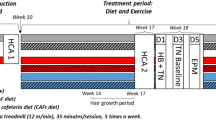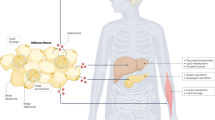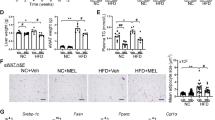Abstract
OBJECTIVE: To investigate whether beacon administration affects substrate utilisation, physical activity levels or energy expenditure in Psammomys obesus.
DESIGN: Pairs of age- and sex-matched Psammomys obesus were randomly assigned to either beacon-treated (15 μg/day for 7 days (i.c.v.)) or control (i.c.v. saline) groups.
MEASUREMENTS: Indirect calorimetry on day 0 and day 7 to measure oxygen consumption and carbon dioxide production, which were used to calculate fat oxidation, carbohydrate oxidation and total energy expenditure. Physical activity in the calorimeter was measured using an infrared beam system. Food intake and body weight were measured daily.
RESULTS: The administration of beacon significantly increased body weight compared to saline-treated control animals. This body weight gain was primarily due to increased body fat content. Average daily food intake tended to be higher in beacon-treated Psammomys obesus, but no effect of beacon administration on substrate oxidation, activity or energy expenditure was detected.
CONCLUSION: The effects of beacon on body weight are due to increased food intake, with no detectable effect on nutrient partitioning, physical activity or energy expenditure.
This is a preview of subscription content, access via your institution
Access options
Subscribe to this journal
Receive 12 print issues and online access
$259.00 per year
only $21.58 per issue
Buy this article
- Purchase on Springer Link
- Instant access to full article PDF
Prices may be subject to local taxes which are calculated during checkout



Similar content being viewed by others
References
Collier GR, McMillan JS, Windmill K, Walder K, Tenne-Brown J, de Silva A, Trevaskis J, Jones S, Morton GJ, Lee S, Augert G, Civitarese A, Zimmet PZ . Beacon. A novel gene involved in the regulation of energy balance Diabetes 2000 49: 1766–1771.
Shafrir E, Gutman A . Psammomys obesus of the Jerusalem colony: A model for nutritionally induced, non-insulin-dependent diabetes J Basic Clin Phys Pharm 1993 4: 83–99.
Walder KR, Fahey RP, Morton GJ, Zimmet PZ, Collier GR . Characterization of obesity phenotypes in Psammomys obesus (Israeli Sand Rats) Int J Exp Diabetes Res 2000 1: 177–184.
Barnett M, Collier GR, Collier FM, Zimmet P, O'Dea K . A cross-sectional and short-term longitudinal characterization of NIDDM in Psammomys obesus Diabetologia 1994 37: 671–676.
Ziv E, Kalman R . Psammomys obesus: primary insulin resistance leading to nutritionally induced type 2 diabetes. In: Sima AAF, Shafrir E (eds). Animal models of diabetes: a primer Harwood Academic: New York 2000 327–342.
Weir JB . New methods for calculating metabolic rate with special reference to protein metabolism. 1949, (Classical article) Nutrition 1990 6: 213–221.
Frayn KN . Calculation of substrate oxidation rates in vivo from gaseous exchange J Appl Physiol 1983 55: 628–634.
Pelleymounter MA, Cullen MJ, Baker MB, Hecht R, Winters D, Boone T, Collins F . Effects of the obese gene product on body weight regulation in ob/ob mice Science 1995 269: 540–543.
Halaas JL, Gajiwala KS, Maffei M, Cohen SL, Chait BT, Rabinowitz D, Lallone RL, Burley SK, Friedman JM . Weight-reducing effects of the plasma protein encoded by the obese gene Science 1995 269: 543–546.
Clark JT, Kalra PS, Crowley WR, Kalra SP . Neuropeptide Y and human pancreatic polypeptide stimulate feeding behaviour in rats Endocrinology 1984 115: 427–429.
Stanley BG, Kyrkouli SE, Lampert S, Leibowitz SF . Neuropeptide Y chronically injected into the hypothalamus: a powerful neurochemical inducer of hyperphagia and obesity Peptides 1986 7: 1189–1192.
Egawa M, Yoshimoto H, Bray GA . Effect of corticotropin releasing hormone and neuropeptide Y on electrophysiological activity of sympathetic nerves to interscapular brown adipose tissue Neuroscience 1990 34: 771–775.
Billington CJ, Briggs JE, Grace M, Levine AS . Effects of intracerebroventricular injection of neuropeptide Y on energy metabolism Am J Physiol 1991 260: R321–R327.
Qu D, Ludwig DS, Gammeltoft S, Piper M, Pelleymounter MA, Cullen MJ, Mathes WF, Przypek J, Kanarek R, Maratos-Flier E . A role for melanin-concentrating hormone in the central regulation of feeding behaviour Nature 1996 380: 243–246.
Rossi M, Choi S, O'Shea D, Miyoshi T, Ghatei M, Bloom S . Melanin-concentrating hormone acutely stimulates feeding, but chronic administration has no effect on body weight Endocrinology 1997 138: 351–355.
Shimada M, Tritos NA, Lowell BB, Flier JS, Maratos-Flier E . Mice lacking melanin-concentrating hormone are hypophagic and lean Nature 1998 396: 670–674.
Sakurai T, Amemiya A, Ishii M, Matsuzaki I, Chemelli RM, Tanaka H, Williams SC, Richarson JA, Kozlowski GP, Wilson S, Arch JR, Buckingham RE, Haynes AC, Carr SA, Annan RS, McNulty DE, Liu WS, Terrett JA, Elshourbagy NA, Bergsma DJ, Yanagisawa M . Orexins and orexin receptors: A family of hypothalamic neuropeptides and G-coupled receptors that regulate feeding behaviour Cell 1998 92: 696–704.
Lubkin M, Stricker-Krongrad A . Independent feeding and metabolic actions of orexins in mice Biochem Biophys Res Commun 1998 253: 241–245.
Chemelli RM, Willie JT, Sinton CM, Elmquist JK, Scammell T, Lee C, Richardson JA, Williams SC, Xiong Y, Kisanuki Y, Fitch TE, Nakazato M, Hammer RE, Saper CB, Yanagisawa M . Narcolepsy in orexin knockout mice: Molecular genetics of sleep regulation Cell 1999 98: 437–451.
Nishino S, Ripley B, Overeem S, Lammers GJ, Mignot E . Hypocretin (orexin) deficiency in human narcolepsy Lancet 2000 355: 39–40.
Taheri S, Ward H, Ghatei M, Bloom S . Role of orexins in sleep and arousal mechanisms Lancet 2000 355: 847.
Acknowledgements
Funding for this work was provided by Autogen Ltd., Australia and Merck-Lipha, Germany.
Author information
Authors and Affiliations
Corresponding author
Rights and permissions
About this article
Cite this article
Walder, K., McMillan, J., Lee, S. et al. Effects of beacon administration on energy expenditure and substrate utilisation in Psammomys obesus (Israeli sand rats). Int J Obes 25, 1281–1285 (2001). https://doi.org/10.1038/sj.ijo.0801662
Received:
Revised:
Accepted:
Published:
Issue Date:
DOI: https://doi.org/10.1038/sj.ijo.0801662
Keywords
This article is cited by
-
Elevated hypothalamic beacon gene expression in Psammomys obesus prone to develop obesity and type 2 diabetes
International Journal of Obesity (2002)



